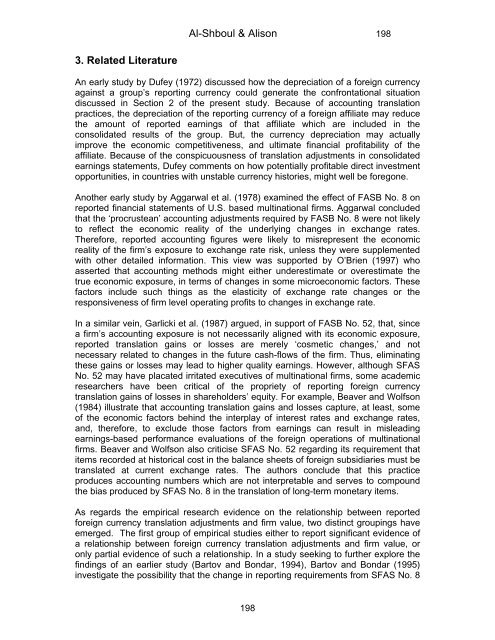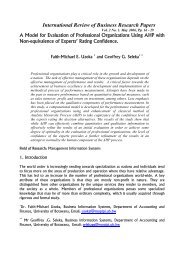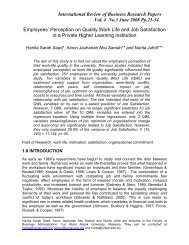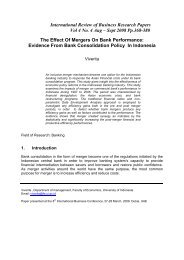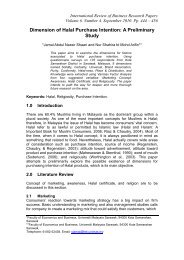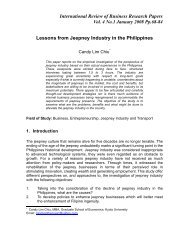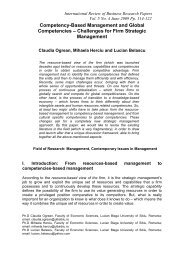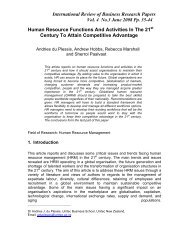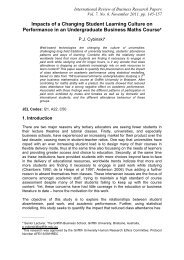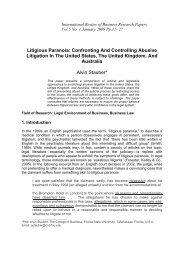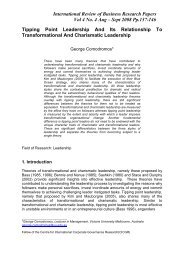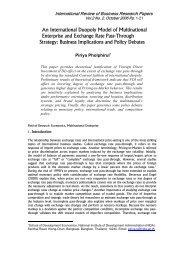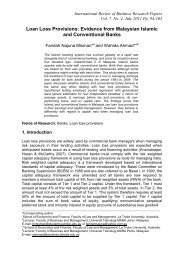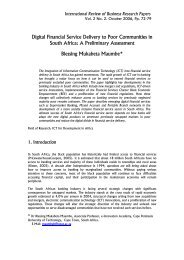Translation Exposure and Firm Value, Evidence From Australian ...
Translation Exposure and Firm Value, Evidence From Australian ...
Translation Exposure and Firm Value, Evidence From Australian ...
You also want an ePaper? Increase the reach of your titles
YUMPU automatically turns print PDFs into web optimized ePapers that Google loves.
Al-Shboul & Alison 1983. Related LiteratureAn early study by Dufey (1972) discussed how the depreciation of a foreign currencyagainst a group’s reporting currency could generate the confrontational situationdiscussed in Section 2 of the present study. Because of accounting translationpractices, the depreciation of the reporting currency of a foreign affiliate may reducethe amount of reported earnings of that affiliate which are included in theconsolidated results of the group. But, the currency depreciation may actuallyimprove the economic competitiveness, <strong>and</strong> ultimate financial profitability of theaffiliate. Because of the conspicuousness of translation adjustments in consolidatedearnings statements, Dufey comments on how potentially profitable direct investmentopportunities, in countries with unstable currency histories, might well be foregone.Another early study by Aggarwal et al. (1978) examined the effect of FASB No. 8 onreported financial statements of U.S. based multinational firms. Aggarwal concludedthat the ‘procrustean’ accounting adjustments required by FASB No. 8 were not likelyto reflect the economic reality of the underlying changes in exchange rates.Therefore, reported accounting figures were likely to misrepresent the economicreality of the firm’s exposure to exchange rate risk, unless they were supplementedwith other detailed information. This view was supported by O’Brien (1997) whoasserted that accounting methods might either underestimate or overestimate thetrue economic exposure, in terms of changes in some microeconomic factors. Thesefactors include such things as the elasticity of exchange rate changes or theresponsiveness of firm level operating profits to changes in exchange rate.In a similar vein, Garlicki et al. (1987) argued, in support of FASB No. 52, that, sincea firm’s accounting exposure is not necessarily aligned with its economic exposure,reported translation gains or losses are merely ‘cosmetic changes,’ <strong>and</strong> notnecessary related to changes in the future cash-flows of the firm. Thus, eliminatingthese gains or losses may lead to higher quality earnings. However, although SFASNo. 52 may have placated irritated executives of multinational firms, some academicresearchers have been critical of the propriety of reporting foreign currencytranslation gains of losses in shareholders’ equity. For example, Beaver <strong>and</strong> Wolfson(1984) illustrate that accounting translation gains <strong>and</strong> losses capture, at least, someof the economic factors behind the interplay of interest rates <strong>and</strong> exchange rates,<strong>and</strong>, therefore, to exclude those factors from earnings can result in misleadingearnings-based performance evaluations of the foreign operations of multinationalfirms. Beaver <strong>and</strong> Wolfson also criticise SFAS No. 52 regarding its requirement thatitems recorded at historical cost in the balance sheets of foreign subsidiaries must betranslated at current exchange rates. The authors conclude that this practiceproduces accounting numbers which are not interpretable <strong>and</strong> serves to compoundthe bias produced by SFAS No. 8 in the translation of long-term monetary items.As regards the empirical research evidence on the relationship between reportedforeign currency translation adjustments <strong>and</strong> firm value, two distinct groupings haveemerged. The first group of empirical studies either to report significant evidence ofa relationship between foreign currency translation adjustments <strong>and</strong> firm value, oronly partial evidence of such a relationship. In a study seeking to further explore thefindings of an earlier study (Bartov <strong>and</strong> Bondar, 1994), Bartov <strong>and</strong> Bondar (1995)investigate the possibility that the change in reporting requirements from SFAS No. 8198


